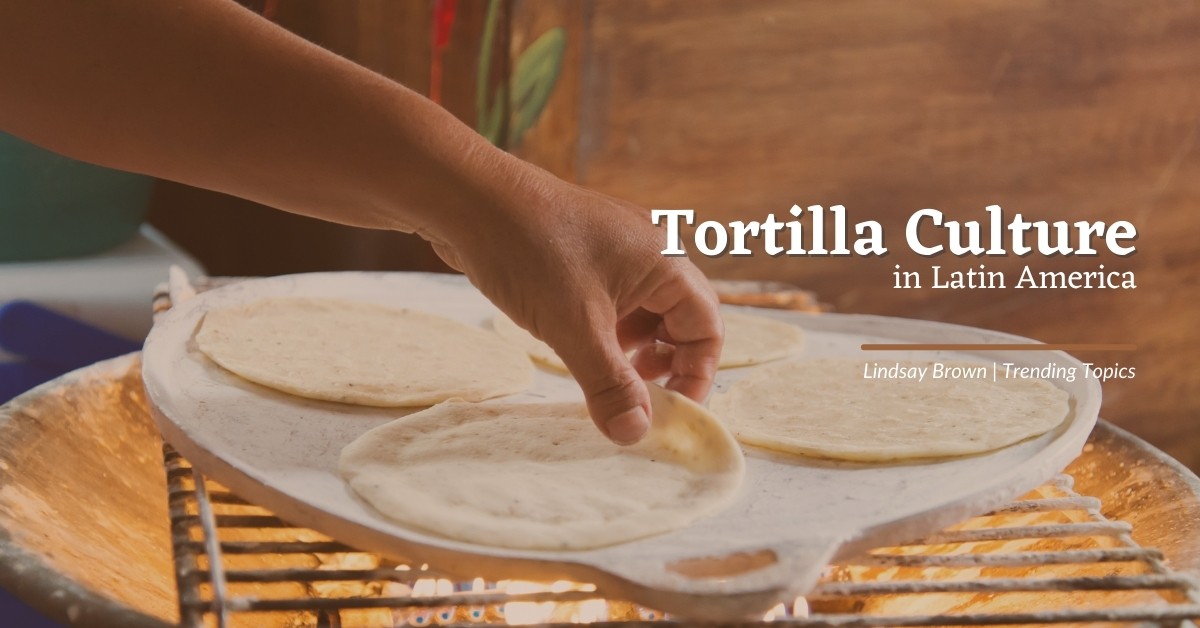
Tortilla Culture in Latin America
A staple of the Central American diet, and the star of every Taco Tuesday, is the modest (yet truly remarkable) tortilla de maíz, or corn tortilla. While we are all pretty familiar with its taste and utility, we may not know much of anything else about this marvelous food. Do you know where the tortilla originated? Or how it’s been made since its creation? And why did copying the corn and tortilla-centered culture of the New World make Europeans deathly ill in the 1500s? The answers will surprise you as there is more to this common comestible than meets the eye.
History
Corn appears in history as a cultivated source of nutrients at least 8,700 years ago in Mesoamerica where the creation story of the tortilla begins. After the indigenous culture of these regions learned to modify teosinte, a type of wild grass, into corn, they began to process the corn into masa, or dough. They did this through an ingenious method called nixtamalization. They soaked the corn kernels in a limewater solution (from limestone, not the fruit lime), which removed the hulls, made it more easily digestible, and helped the ground corn form a dough (instead of turning into mush) for tortilla-making. The resulting mixture of masa is called nixtamal, an Aztec word for hominy. Interestingly, the chemical process of mixing corn with lime releases a crucial vitamin that is otherwise unavailable to the human body. When the Europeans learned to farm corn from the natives of the New World in the early 1500s, they failed to copy the process of nixtamalization. Eventually, high corn yields in European fields led to high corn consumption, and vast populations whose diets relied primarily on corn became extremely sick, often dying, from a severe type of malnutrition called pellagra.
Nutritional Value
The corn tortilla is an extraordinary human invention. Coined tortilla by the Spaniards who compared it to a smaller version of the torta (cake) they knew back home, this small round corn cake packs a hefty punch of nutrition. Thanks to the process of nixtamalization, tortillas are rich in minerals like calcium, iron, and magnesium and provide essential vitamins like A, B, and E. They are also a good source of protein and fiber. Indigenous cultures named corn, beans, and squash the Three Sisters, since they grew better together and created a perfectly balanced diet for health and well-being.
Preparation
The traditional recipe for any tortilla includes corn, water, and lime (called cal in Spanish) to make the nixtamal. The women are typically responsible for making tortillas for family members or consumers who may buy from their tortillería (tortilla shop). They prepare a comal (a hot griddle made out of light sheet-metal), then dampen the nixtamal on a table, mix it well, and break off pieces to be formed into thin, circular patties. The process of creating perfectly round tortillas that are uniform in thickness is an art form that many women start learning at a young age. They lay the tortillas on the hot griddle for a minute or two and then flip them over by pressing lightly into each one with damp fingers. When the tortillas are finished, they gather them up while piping hot and store them insides baskets with thick pieces of cloth to keep them warm.

Tortilla Variations by Region
While tortilla culture extends from Mexico to Argentina, it is much more frequently consumed in Central America. Specifically, in Mexico, Guatemala, El Salvador, and Nicaragua, tortillas are eaten daily by the majority of the population. Costa Rica and Panama do partake in tortilla-making, but it is becoming less common and most people simply eat pre-packaged tortillas. Nicaraguans consume a thick, sweet type of tortilla called güiriles that they serve with crumbled cheese. Tortillas in Argentina, Bolivia, and Chile are smaller than those in Central America. They have salty tortillas called sopaipilla and sweet ones that are boiled in sugar water. Many countries in Central and South America continue to make use of masa in different ways, crafting the corn dough into unique and culturally-defining foods.
Different Tortilla Dishes
Tortillas vary in size from 6 cm to over 30 cm, depending on the type of dish they will be used for. While the tortilla is often consumed on its own as a side dish to any meal, it is also modified to create specific dishes. Here is a list of dishes made with the tortilla, showing what they are and where they originated:

Tortillas in Guatemala
In Guatemala, where Homeschool Spanish Academy is based, the tortilla is a main staple of most people’s diets (along with beans and some type of meat). There is a tortillería on every corner, where some families go to buy freshly made tortillas los tres tiempos (three times a day). Other families buy corn to grind or grow their own in order to make masa nixtamalizada for their homemade tortillas. For each meal, the family gathers together with big piles of steamy tortillas packed away in canastas de mimbre, or wicker baskets. The amount of tortillas eaten by each person varies by preference, averaging from two to eight per person per meal. In many cases, the tortilla replaces use of a fork or spoon, as it’s used to scoop up black beans and rice (for example). It’s also frequently rolled up and dipped into savory dishes like a hearty guisado (stew) or jocón (tomatillo-cilantro spiced gravy).
Try Your Own Tortillas
Would you like to try to make your own tortillas at home? Check out this helpful recipe and with a bit of practice, you can make your own delicious corn tortillas for any dish. We hope you enjoyed learning about tortilla culture in Latin America. Sign up for a free class with a native Spanish speaker in Guatemala and let us know how your tortilla-making experience is going!

Would you like to learn more about Latin American culture? Check these out!
- The Best Spanish Learning Podcasts for Kids
- 12 Contemporary Spanish Female Artists Who Will Empower You
- The History and Significance of Guatemalan Jade
- Are Bilingual Children More Likely to Experience a Speech or Language Delay?
- Top 10 Places to Visit in Guatemala City, Guatemala
- Learn About Hispanic History: Were Hispanics Slaves?
- Celebrating Culture and Joy: The Magic of Carnival in Spanish-Speaking Countries
- 15 Mouth-Watering National Dishes of Latin America
- Top-Rated Accredited Online Spanish Classes for Kids - February 22, 2023
- 6 Compelling Reasons Why Your School Should Outsource Spanish Class - February 3, 2023
- 20 Free Spanish Books, Novels, and Stories in PDF and Printables - January 25, 2023




